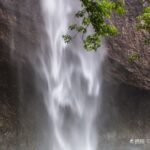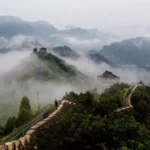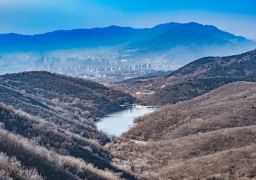Shuanglin Grottoes is a newly-built scenic spot in the Dafo Scenic Area after the open-air Maitreya, Prajna Valley and Dinosaur Park. This scenic spot was a quarry in the Ming and Qing Dynasties. Later, plank roads were built, tunnels were dug, and Buddhas were carved along the mountains. A large cave with a large space and a large reclining Buddha were excavated in the mountains. The reclining Buddha hall has now become another tourist attraction with Buddhist culture as the theme after the ‘First Giant Buddha in Jiangnan’, adding luster to the Dafo Temple known as the ‘Dunhuang of Yue State’.
On the left side 300 meters from the entrance of the Dafo Temple, the first thing you see is the stone tablet of Shuanglin Grottoes. After passing the stone tablet, there is the Mirror Lake. Ascending the steps on the left, after walking up 200 steps and passing through the winding and secluded cave, you will arrive in front of the hall. The hall door is divided into seven bays, majestic and solemn. It has a single-eaved double-rafter structure with delicate brackets and appropriate proportions, presenting the architectural style of the Tang Dynasty. The left and right cliff walls are carved with relief techniques, featuring two 7-meter-tall generals Heng and Ha, with grand scale and majestic might. Entering the arch is the front hall. The left and right caves are Bodhisattva Manjusri and Bodhisattva Samantabhadra. Manjusri rides a blue lion. The blue lion represents might. Holding scriptures in his hand, he is the first eminent disciple of the Buddha. He is the first in wisdom and eloquence and assists the Buddha in promoting Buddhism. He is the head of all bodhisattvas. Worshiping Manjusri can eliminate stupidity and obtain wisdom and develop intelligence. Samantabhadra sits on a six-tusked white elephant. The white elephant represents peace and power. Samantabhadra symbolizes truth. The heads of the blue lion and the white elephant are facing outward, indicating the protection of Buddhism. Entering the main hall, you will see a scene of peace and holiness. The main hall is also a grotto. It is 23 meters deep and 48 meters wide. A reclining Buddha is carved from the original mountain. The reclining Buddha lies quietly on the Sumeru lotus throne. The Buddha statue is 37 meters long and 9 meters high. The image of the reclining Buddha refers to the Giant Buddha in Dunhuang, Longmen and at the Temple of Heaven. From the hair to the facial features, from a clothing pattern to the angle of placing the hands and feet, after several discussions and revisions by domestic authoritative experts and eminent monks, this plan was finally determined.Opening hours: From May 1st to September 30th, it is open from 06:00 to 17:30; from October 1st to April 30th, it is open from 06:00 to 17:00.










